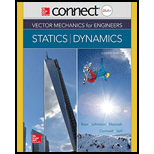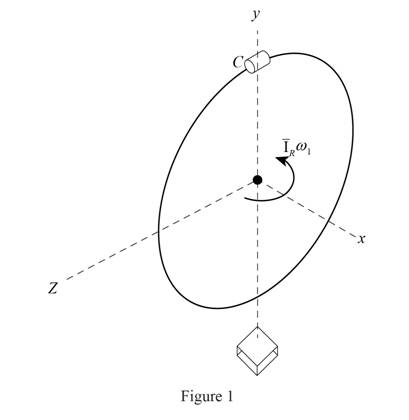
A small 4-lb collar C can slide freely on a thin ring of weight 6 lb and radius 10 in. The ring is welded to a short vertical shaft, which can rotate freely in a fixed bearing. Initially, the ring has an angular velocity of 35 rad/s and the collar is at the top of the ring (θ = 0) when it is given a slight nudge. Neglecting the effect of friction, determine (a) the angular velocity of the ring as the collar passes through the position θ = 90°, (b) the corresponding velocity of the collar relative to the ring.

Fig. P17.91
(a)
Find the angular velocity of the ring as the collar passes through the position
Answer to Problem 17.91P
The angular velocity of the ring as the collar passes through the position
Explanation of Solution
Given information:
The weight
The weight
The initial angular velocity
Calculation:
Find the mass
Substitute 4 lb for
Find the mass
Substitute 6 lb for
Sketch the component of velocity of the given system at initial position as shown in Figure (1).

Find the centroidal moment of inertia
Here, R is the radius of the ring.
The collar C is located at top of the ring at initial position. Therefore, the angle
Sketch the component of velocity of the given system at final position as shown in Figure (2).

Refer Figure (2).
Write the equation of the velocity
Here,
Consider the conservation of angular momentum.
Substitute
Simplify the Equation.
Substitute
Thus, the angular velocity of the ring as the collar passes through the position
(b)
Find the corresponding velocity of the collar relative to the ring.
Answer to Problem 17.91P
The corresponding velocity of the collar relative to the ring is
Explanation of Solution
Calculation:
Find the equation of the kinetic energy
Substitute
Find the equation of the potential energy
Find the equation of the kinetic energy
Substitute
The potential energy of the system at final position
Consider the conservation of energy.
Substitute
Substitute
Thus, the corresponding velocity of the collar relative to the ring is
Want to see more full solutions like this?
Chapter 17 Solutions
Connect 2 Semester Access Card for Vector Mechanics for Engineers: Statics and Dynamics
Additional Engineering Textbook Solutions
Fundamentals of Aerodynamics
Foundations of Materials Science and Engineering
Engineering Mechanics: Statics
Engineering Mechanics: Statics
Introduction To Finite Element Analysis And Design
Fluid Mechanics Fundamentals And Applications
- A 5.32-kg disk A of radius 0.445 m initially rotating counter-clockwise at 436 rev/min is engaged with a 6.72-kg disk B of radius 0.275 m initially rotating clockwise at 528 rev/min, where the moment of inertia of a disk is given as I = ½ mi?. Determine their combined angular speed (in rpm) and direction of rotation after the meshing of the two disks. Remember to show clearly the equations that you use!!'arrow_forwardA 48-kg advertising panel of length 2a = 2.4 m and width 2b = 1.6 m is kept rotating at a constant rate w1 about its horizontal axis by a small electric motor attached at A to frame ACB. This frame itself is kept rotating at a constant rate w2 about a vertical axis by a second motor attached at C to the column CD. Knowing that the panel and the frame complete a full revolution in 6 s and 12 s, respectively, express, as a function of the angle 0, the dynamic reaction exerted on column CD by its support at D.arrow_forwardA long ladder of length l, mass m, and centroidal mass moment of inertia I is placed against a house at an angle 0=0O. Knowing that the ladder is released from rest, determine the angular velocity of the ladder when 0=02. Assume the ladder can slide freely on the horizontal ground and on the vertical wall.arrow_forward
- Disk A, of weight 10 lb and radius r = 6 in., is at rest when it is placed in contact with belt BC, which moves to the right with a constant speed v = 40 ft/s. Knowing that μk = 0.20 between the disk and the belt, determine the number of revolutions executed by the disk before it attains a constant angular velocity.arrow_forwardA 3-kg bar AB is attached by a pin at D to a 4-kg square plate, which can rotate freely about a vertical axis. Knowing that the angular velocity of the plate is 120 rpm when the bar is vertical, determine (a ) the angular velocity of the plate after the bar has swung into a horizontal position and has come to rest against pin C, (b) the energy lost during the plastic impact at C.arrow_forwardThe 2-lb gear A is constrained to roll on the fixed gear B but is free to rotate about axle AD. Axle AD has a length of 20 in., a negligible weight, and is connected by a clevis to the vertical shaft DE that rotates as shown with a constant angular velocity w1. Assuming that gear A can be approximated by a thin disk with a radius of 4 in., determine the largest allowable value of w1 if gear A is not to lose contact with gear B.arrow_forward
- A semicircular panel with a radius r is attached with hinges to a circular plate with a radius r and initially is held in the vertical position as shown. The plate and the panel are made of the same material and have the same thickness. Knowing that the entire assembly is rotating freely with an initial angular velocity of w0 , determine the angular velocity of the assembly after the panel has been released and comes to rest against the plate.arrow_forwardEach of the gears A and B has a mass of 675 g and a radius of gyration of 40 mm, while gear C has a mass of 3.6 kg and a radius of gyration of 100 mm. Assume that kinetic friction in the bearings of gears A, B C produces couples of constant magnitude 0.15 N.m, 0.15 N.m, 0.3 N.m, respectively. Knowing that the initial angular velocity of gear C is 2000 rpm, determine the time required for the system to come to rest.arrow_forwardThe ends of a 9-lb bar AB are constrained to move along slots cut in a vertical plate as shown. A resource of constant k = 3 lb/in. is attached to end A such that its tension is zero when e=0. If the bar is released from rest when e = 0, determine the angular velocity of the bar and the velocity of end B when =30°arrow_forward
- The blade of a portable saw and the rotor of its motor have a total weight of 2.5 lb and a combined radius of gyration of 1.5 in. Knowing that the blade rotates as shown at the rate w1= 1500 rpm, determine the magnitude and direction of the couple M that a worker must exert on the handle of the saw to rotate it with a constant angular velocity w2= -(2.4 rad/s)j.arrow_forwardTwo panels A and B are attached with hinges to a rectangular plate and held by a wire as shown. The plate and the panels are made of the same material and have the same thickness. The entire assembly is rotating with an angular velocity w0 when the wire breaks. Determine the angular velocity of the assembly after the panels have come to rest against the plate.arrow_forwardA 1.6-kg tube AB can slide freely on rod DE which in turn can rotate freely in a horizontal plane. Initially the assembly is rotating with an angular velocity of magnitude w = 5 rad/s and the tube is held in position by a cord. The moment of inertia of the rod and bracket about the vertical axis of rotation is 0.30 kg.m2 and the centroidal moment of inertia of the tube about a vertical axis is 0.0025 kg.m2If the cord suddenly breaks, determine (a) the angular velocity of the assembly after the tube has moved to end E, (b) the energy lost during the plastic impact at E.arrow_forward
 Elements Of ElectromagneticsMechanical EngineeringISBN:9780190698614Author:Sadiku, Matthew N. O.Publisher:Oxford University Press
Elements Of ElectromagneticsMechanical EngineeringISBN:9780190698614Author:Sadiku, Matthew N. O.Publisher:Oxford University Press Mechanics of Materials (10th Edition)Mechanical EngineeringISBN:9780134319650Author:Russell C. HibbelerPublisher:PEARSON
Mechanics of Materials (10th Edition)Mechanical EngineeringISBN:9780134319650Author:Russell C. HibbelerPublisher:PEARSON Thermodynamics: An Engineering ApproachMechanical EngineeringISBN:9781259822674Author:Yunus A. Cengel Dr., Michael A. BolesPublisher:McGraw-Hill Education
Thermodynamics: An Engineering ApproachMechanical EngineeringISBN:9781259822674Author:Yunus A. Cengel Dr., Michael A. BolesPublisher:McGraw-Hill Education Control Systems EngineeringMechanical EngineeringISBN:9781118170519Author:Norman S. NisePublisher:WILEY
Control Systems EngineeringMechanical EngineeringISBN:9781118170519Author:Norman S. NisePublisher:WILEY Mechanics of Materials (MindTap Course List)Mechanical EngineeringISBN:9781337093347Author:Barry J. Goodno, James M. GerePublisher:Cengage Learning
Mechanics of Materials (MindTap Course List)Mechanical EngineeringISBN:9781337093347Author:Barry J. Goodno, James M. GerePublisher:Cengage Learning Engineering Mechanics: StaticsMechanical EngineeringISBN:9781118807330Author:James L. Meriam, L. G. Kraige, J. N. BoltonPublisher:WILEY
Engineering Mechanics: StaticsMechanical EngineeringISBN:9781118807330Author:James L. Meriam, L. G. Kraige, J. N. BoltonPublisher:WILEY





